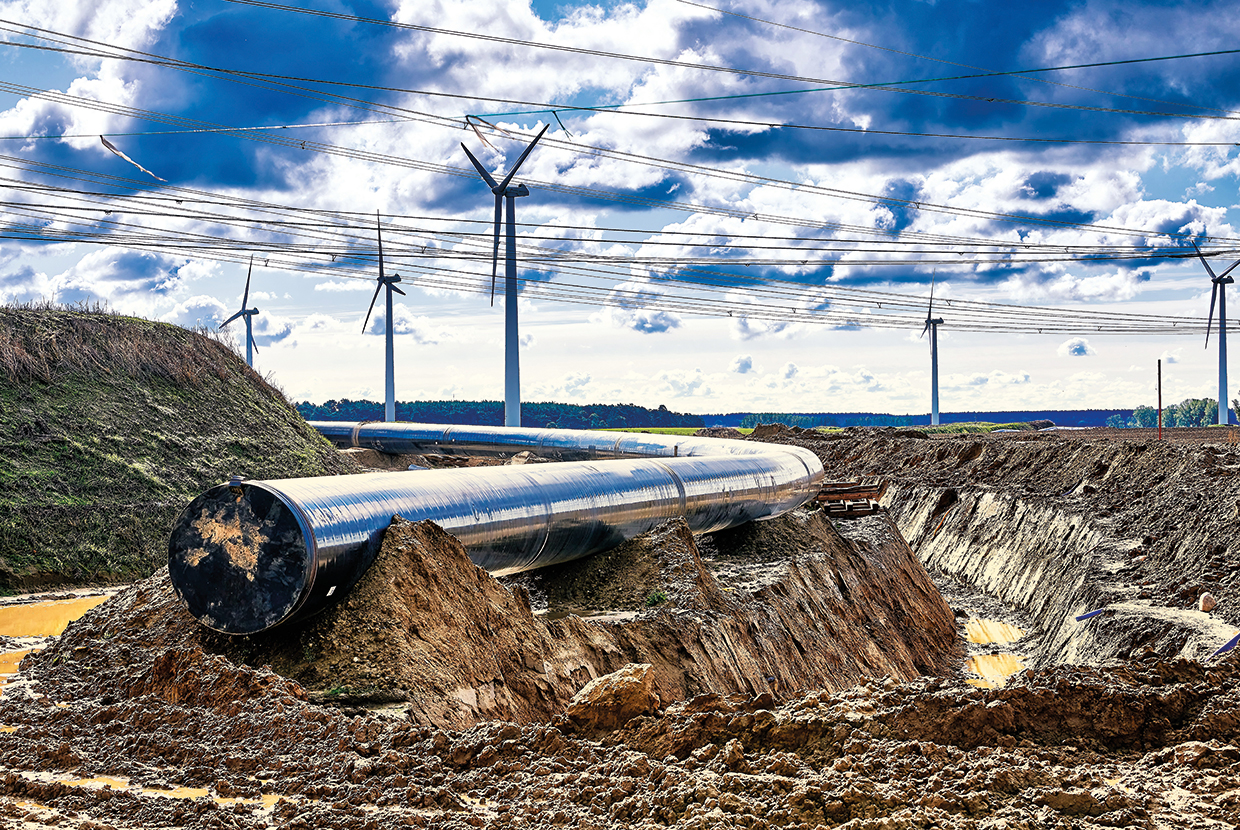Major banks, traders and energy companies have rallied behind gas, touting it as a transitional fuel that will smooth a global shift to renewable energy. But climate campaigners say reliance on natural gas will continue to produce devastating carbon emissions, while a much-hyped alternative – green hydrogen – is unsuited to take its place. John Basquill reports.
Fossil fuels are rapidly falling out of favour for global banks. Against a backdrop of shareholder pressure, NGO campaigning and regulatory reforms, numerous financial institutions and investors have unveiled plans to move towards net-zero carbon emissions across their portfolios over the coming years.
The heavy pollution produced by burning coal means producers and traders are faced with increasingly limited financing options from both the public and private sectors, and signs are emerging that oil could be on a similar trajectory. But for gas, the situation is more nuanced.
Natural gas is seen by many lenders, traders and energy producers as a transitional fuel, taking the place of coal or oil in the immediate term while renewable energy investment and capacity is ramped up. At the same time, hydrogen has been touted as a longer-term replacement for fossil gas, as it can be generated by renewable electricity and used as carbon-free fuel.
That is not the full picture, however. Climate researchers and NGOs are highly sceptical over the role of gas in the planet’s future energy mix. The pollution that would be caused by more natural gas usage is a concern, with the International Energy Agency (IEA) warning that an immediate halt to all new fossil fuel projects would be required in order to reach net-zero carbon emissions by 2050.
With hydrogen, meanwhile, there are practical challenges to overcome. Experts warn that a staggering amount of renewable electricity would be required to provide hydrogen as a like-for-like replacement for existing natural gas functions. Meanwhile, questions over the viability of hydrogen-related infrastructure could burden project backers with stranded assets, while leaving banks and energy companies open to accusations of greenwashing.
Natural gas and the energy transition
Some banks and traders have been vocal in their support for natural gas as a transitional fuel.
Wiebe Draijer, chairman of the managing board at Rabobank, told Bloomberg in February that the Dutch lender expects the share of gas in its portfolio of trade and commodity finance lending to energy companies to grow to 25% by 2025.
A Rabobank spokesperson tells GTR it is “in the top 10 financial institutions worldwide to finance green energy”, with renewables accounting for 88% of its energy portfolio. Its involvement in coal mining, directly and indirectly, has been “reduced to almost zero”.
However, the bank adds: “In the coming years, since solar and wind energy will not meet the total demand, we still need gas in our supply chain. As a financier, we also take into account the pace of our government, of consumers and businesses, to ‘getting off gas’.”
The spokesperson was unable to confirm what proportion of its portfolio currently involves gas, but says more details will be available when its updated energy strategy is published in Q2 this year.
In Australia – historically the world’s largest exporter of liquified natural gas (LNG), though tipped to lose that crown to the US – the picture is similar.
ANZ’s chief executive, Shayne Elliott, said in November last year it expected funding for LNG projects to grow in the short term, with its usage as a replacement for more polluting fuels yet to reach its peak. NAB is also winding down its support for gas only gradually, calling for “an orderly transition of Australia’s energy system”.
Energy producers and traders have made similar arguments. A report from BP published in 2020 says the role of all fossil fuels will decline over time, but that natural gas “remains more resilient than either coal or oil”.
“Gas, including biomethane, can play an important role in developing economies by supporting an earlier switch away from coal; in particular, in emerging Asia, where the share of coal in the energy mix is currently high and overall energy demand is growing strongly,” it says.
“It also continues to play a role in the longer term in a decarbonised form, thanks to carbon capture, utilisation and storage technology.”
Similarly, Rob Abbott, group treasurer at Vitol, said at last year’s GTR Commodities event in Geneva that the energy and commodities giant “believes gas is genuinely a transitional fuel”.
In other cases, lenders’ energy transition policies incorporate a gradual phase-out of gas but continue to provide project and trade finance facilities in the immediate term.
In January, a group of 18 banks provided a loan to Global Infrastructure Partners so it could purchase a 49% stake in Pluto 2, a major LNG project in Australia, after its operator Woodside Energy opted to sell part of its non-operating interest. Other participants include local lenders ANZ, NAB and Westpac, as well as international banks HSBC, Mizuho, MUFG and Standard Chartered.
Woodside Energy, the country’s largest gas producer, says the loan enabled it to go ahead with Pluto 2, which involves construction of a floating production unit for a new offshore gas field, as well as transport and processing facilities.
Divided opinions
Industry opinion is divided on the usefulness of natural gas as a replacement for other fossil fuels. Despite its call for an immediate halt to new projects, the IEA estimated in 2019 that over the previous nine years, efforts to switch from coal to gas had saved around 500 million tonnes of CO2.
That was comparable with replacing 200 million vehicles with zero-carbon electric equivalents over the same period, it said.
“Natural gas is one of the mainstays of global energy,” IEA executive director Fatih Birol said at the time. “Where it replaces more polluting fuels, it improves air quality and limits emissions of carbon dioxide.”
The IEA’s report predates its call for an immediate halt to new fossil fuel projects, which was issued in June 2021. In that report – a highly influential piece of research heavily cited during the Cop26 summit in Glasgow – the IEA calls for the industry to focus solely on output and emissions reductions from existing assets.
ClientEarth, an environmental NGO that uses the legal system to fight climate change, argues that the gas industry “has misled decision-makers and populations with the notion that gas is needed in order to fill a gap between decreasing coal and oil production and ramping up renewable forms of energy”.
“This argument doesn’t stack up,” it says in a July 2021 report. “There are viable, clean alternatives to gas, which are either already cheaper or very soon will be. In most of Europe, these renewable alternatives are readily available.”
Mia Watanabe, a campaigner at shareholder activist group Market Forces, says the scientific basis for cutting funding to natural gas “couldn’t be clearer”.
“The IEA’s net-zero emissions by 2050 scenario explicitly states that there can no longer be any new coal, oil or gas projects,” she tells GTR. “That’s not starting from tomorrow, or starting in 2029 – it’s starting from last year. What’s clear about the science is that this transition needs to happen now, and there can’t be any excuses.”
Market Forces has been highly critical of the banks supporting Woodside’s Pluto 2 project. It argues the facility would enable 1.6 billion tonnes of carbon emissions over its lifetime, “equivalent to running 15 coal power stations for 30 years”, or around 3.5 times the UK’s annual territorial emissions.
“Ramping up production of gas isn’t going to lead us to a safe and stable climate. It’s just recycling the same business model, but for another fossil fuel product that’s still wrecking the climate,” Watanabe says.
Another concern is that emissions data may not be complete, as methane leakage from existing LNG facilities is so difficult to monitor. Tara Connolly, senior gas campaigner at Global Witness, points out that Europe imports around 90% of its gas, making it difficult for end users to ascertain how much has escaped during that process.
“We rely on LNG from countries like the US, Russia and Qatar, and no one really knows what the methane leakage rates are,” she tells GTR. “When you take that into account, the idea that it’s always less polluting than coal is questionable. Both need to be phased out urgently.”
Green hydrogen and greenwashing
Despite doubts over the long-term viability of natural gas, there is currently a sense of optimism among policymakers that hydrogen could take its place as a source of fuel. Hydrogen can be generated using only renewable energy, via electrolysis, can be stored for future use, and generates no carbon emissions.
The EU Gas Package, a proposed framework unveiled by the European Commission in December, aims to bring energy security to the bloc by facilitating the uptake of “renewable and low carbon gases, including hydrogen” as well as biomethane. Draft legislation includes reforms aimed at developing a European hydrogen market and associated infrastructure.
The vision includes an ambition that all long-term contracts for unabated fossil natural gas are not extended beyond 2049.
Frans Timmermans, executive vice-president for the European Green Deal, argues: “Europe needs to turn the page on fossil fuels and move to cleaner energy sources. This includes replacing fossil gas with renewable and low carbon gases, like hydrogen.”
There are examples where the use of hydrogen appears to be a practical and achievable option.
A “hydrogen ladder” developed by Michael Liebreich, chief executive of Liebreich Associates and an advisor to the UK government’s Board of Trade, ranks potential use cases from “unavoidable” to “uncompetitive”.
At the more positive end of the scale, functions include the production of fertiliser, steel or chemical feedstock. Other examples include shipping – in the form of ammonia or e-fuel – as well as off-road vehicles, long-term storage and certain industrial processes.
But most transport-related applications are not considered suitable, including short and medium-haul flights, rural and metro trains or buses, and hydrogen fuel cell cars. Other unrealistic use cases include domestic and commercial heating, currently a major component of Europe’s gas grid.
The ladder “is intended to debunk the naive view of clean hydrogen as the Swiss Army Knife of the future net-zero economy”, Liebrich explains.
“Just because you could technically do something with clean hydrogen, it doesn’t mean you will.”
One major issue is efficiency. Client Earth says it is currently “unclear whether green hydrogen… will be available at a reasonable cost and at scale in the near future” and so cannot, in and of itself, justify developing new gas infrastructure.
Oslo-headquartered Bellona Europe, an environmental NGO, estimates that a gas power plant using 100% renewable hydrogen – measured by EU Taxonomy standards – would consume 2.8 times more electricity than it would produce.
“Hydrogen is an energy carrier, not an energy source,” Keith Whiriskey, Bellona Europe’s deputy director, tells GTR. “You’re putting renewable electricity in, you’re turning that into hydrogen, and then you’re using that hydrogen in a gas power plant to make electricity.”
With each conversion between electricity and hydrogen, more energy is lost. However, according to Whiriskey, that inefficiency does not seem to have been factored into the European Commission’s infrastructure vision for hydrogen.
“The idea is that if hydrogen will be plentiful in the future, and freely available, all the investments we make in gas today are net-zero compliant because that gas can be swapped out with renewable gas in the future,” he says. “In reality, that means companies can build gas power plants today that are ‘hydrogen-ready’, and just continue burning natural gases.”
Financing gas infrastructure projects on the assumption that hydrogen will be widely available in the future could leave investors with stranded assets, or unable to meet climate targets, Global Witness’ Connolly points out.
“If this hydrogen backbone doesn’t materialise, those investments are going towards a future that is never going to transpire,” she says. “For example, there could be a rapid decommissioning of assets where it doesn’t make sense to use hydrogen, such as for heating buildings. If you’re investing in those kinds of distribution systems, there’s a huge risk there; you’re essentially investing in us not meeting our climate targets.”






